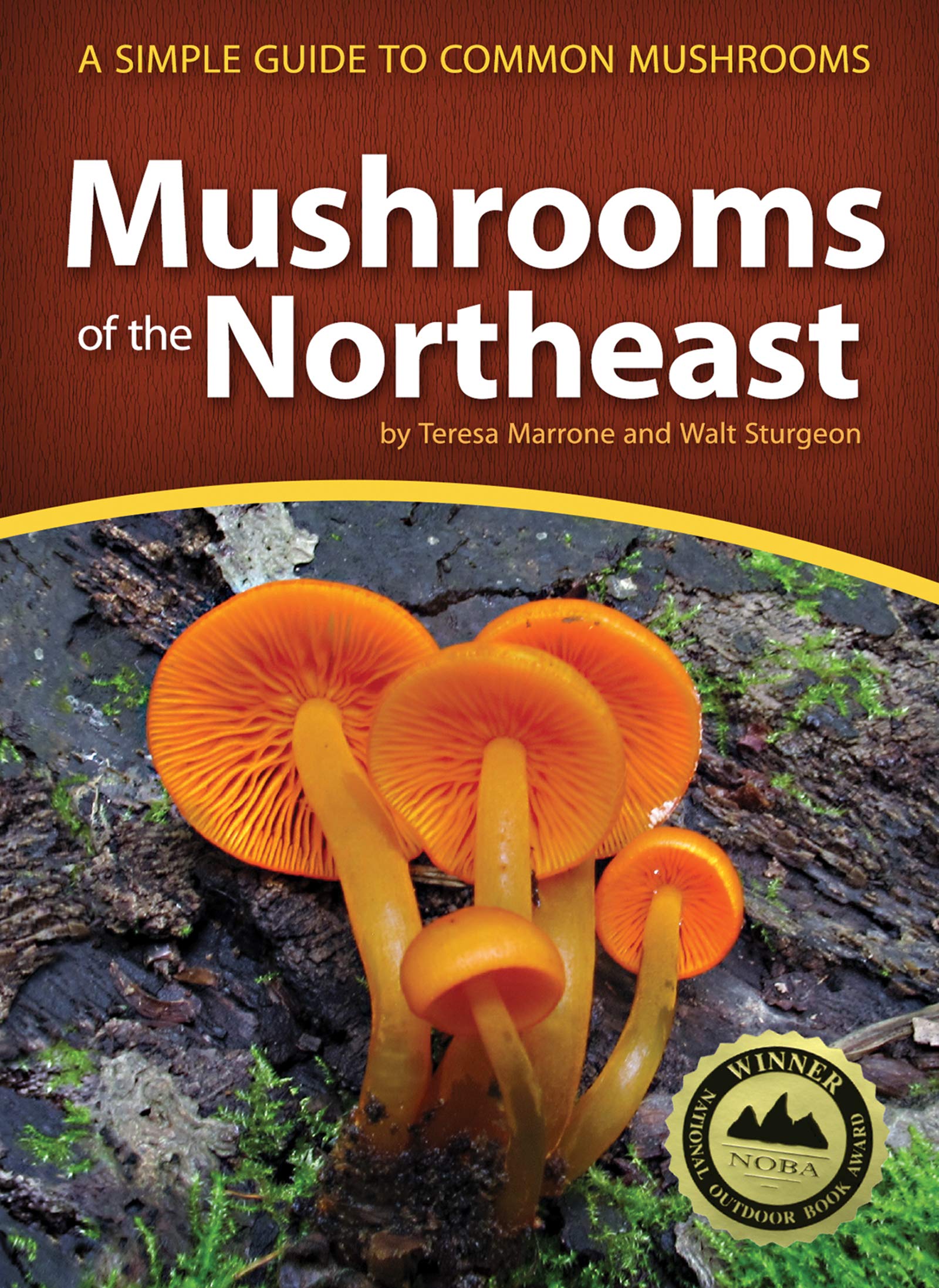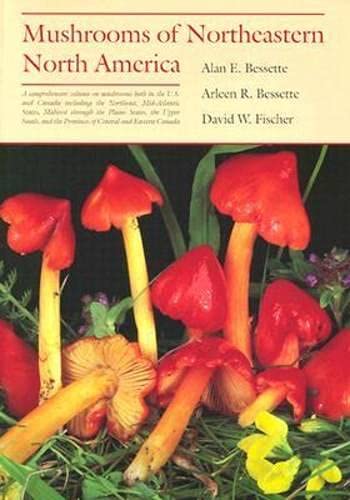New York State is famous as the location of New York City, but large areas of the state are rural or even wooded. Even suburban and urban areas have their wild pockets, whether by neglect or design. And in those wild areas, big and small, are large numbers of many popular, edible mushroom species—and not a few that are not edible, but are worth knowing for their interest, their beauty, or so you know for sure what not to eat[i].
The following list is by no means exhaustive. It’s just a short collection of mushrooms that can found in the state of New York. It’s important not to go foraging for the table alone until you have developed a fair degree of expertise at mushroom identification, though—it takes practice to develop the ability to notice the important details of a new topic, be it mycology or, say, classic cars. Until then, even if you have read all about a lot of species, it will be easy to overlook distinctions. Effectively, edible species will have a lot more toxic look-alikes than they do when an expert looks at them.
I cannot stress enough that this list is merely educational and not to be used in place of a field guide, spore prints, or an identification app. Even more preferable is an expert to guide. you in person. If you do end up going out mushroom hunting make sure you take a quality knife with you and a basket/bag for your finds!
Our Recommended Field Guides for New York
COVER | TITLE | Header | ||
|---|---|---|---|---|
OUR #1 RATED | ||||
Edible Wild Mushrooms in New York
Chicken-of-the-Woods (Laetiporus sp.)

Chicken is one of those mushrooms consistently recommended to beginners because it is easy to identify, has few close look-alikes, and, as everybody knows, it’s edible.
So why does it sometimes make people sick?
There have been several possible explanations advanced over the years, but it turns out the real reason is pretty simple: chicken-of-the-woods is not a single species but rather a whole group of closely-related, similar-looking species, some of which are mildly toxic[ii]. Others are perfectly safe. Because some new chicken species may still not have been identified yet, it’s difficult to say which species New York has. Interested eaters should try a little at a time and see how it goes. It does taste like chicken.
Hen-of-the-Woods (Grifola frondosa)
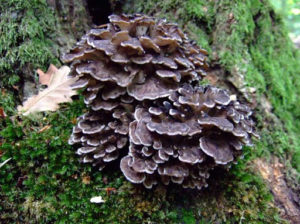
Hen-of-the-woods has nothing to do with chicken-of-the-woods except for both being named in honor of the same bird. “Chicken” is named for its taste, while “hen” is presumably a reference to the mushroom’s appearance, which is sometimes like a pile of large, gray feathers. It’s also sometimes sold under its Japanese name, maitake. By any name, the species is a popular edible that goes surprisingly well grilled with melted cheese like a cheese-steak.
Giant Puffball (Calvatia gigantea)
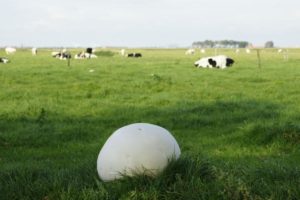
The Giant Puffball[iii] is white, smooth, more or less ball-shaped or lump-shaped, and can be anywhere from large to very, very, very large. While some other mushrooms, such as a toxic earthball or a Deadly Amanita in its egg stage, can be mistaken for some puffball species, the giant puff is usually too big to be mixed up with anything else. It’s a popular edible, if harvested before the spores start to mature. The only problem is that its protein content is so high that it goes bad quickly if left out, yet a whole one won’t fit in the fridge[iv]. Have a plan before you pick.
Bear’s-Head Tooth (Hericium americanum)
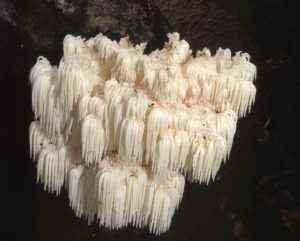
The awkward name makes more sense if one remembers to include the hyphen; this is a tooth mushroom (that is, one covered my long, soft spines or teeth) named after a bear’s head, not a “head tooth” mushroom. In any case, these are often referred to as “Lion’s Mane,” a name that more properly belongs to H. erinaceus. Even many otherwise well-informed writers tend to treat all Hericiums as interchangeable even for medicinal purposes, an equivalence for which there is no evidence. These are different species. Reportedly, they do taste the same, though, with a surprisingly crab-like flavor. The soft spines do not alter the texture of the mushroom at all—you won’t notice them.
Golden Chanterelle (Cantharellus cibarius)
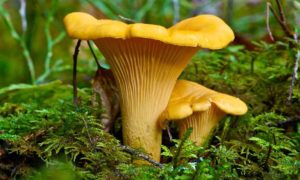
The golden is the most famous Chanterelle, the one people mean if they say “Chanterelle” and don’t specify which kind. It is a large, beautiful, and flavorful mushroom, notable for its yellow color, trumpet-like shape, and the presence of ridges, rather than gills, on its outer surface. Poisonous Jack o’Lanterns (Omphalotus olearius) are sometimes mistaken for chants because of the color, but Jack-o’Lanterns have definite gills.
King Bolete (Boletus sp.)
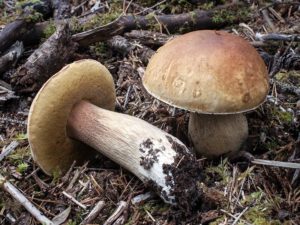
King boletes[v], or porcinis, are large and delicious mushrooms with pores, rather than gills, under the cap. There are pored mushrooms that are not as good, and some are even toxic, but attention to detail should be enough to recognize the king. Unfortunately, porcini is another “species” that has turned out to be an entire group. It’s not entirely clear which species New York has.
Oyster (Pleurotus ostreatus)
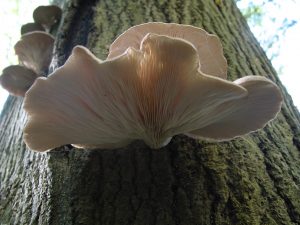
There are many Oyster Mushrooms, but if someone doesn’t specify, this is likely the species they mean. It is distinctive-looking, with few look-alikes, and a mild but lovely flavor. The flesh is soft, even delicate. The name reflects the appearance—very, very, vaguely oyster-like—not the taste.
Magic Mushrooms in New York
Yes, a variety of “magic” mushrooms, those containing psilocybin and other hallucinogenic substances, so grow wild in the state of New York[vi]. They are illegal to use or even possess according to both state and Federal law. Please do not use the following information to get convicted of felonies.
Also, please do not die attempting to use hallucinogenic mushrooms. The “magic” species themselves are relatively safe, but they have a toxic look-alike—and that could kill you. Positively identify every mushroom before eating it!
Gymnopilus

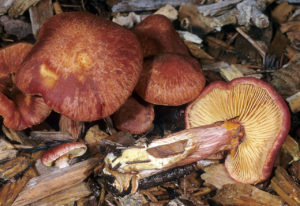

Gymnopilus is a large genus, but only a few of its members are “active.” Even those that are aren’t well-known among psychonauts—they simply aren’t as often used as the Psilocybes or the pans. People who have tried them often report a qualitatively different high. Active gyms contain psilocyben, but they may contain something else, too. Most are small, yellow-brown mushrooms. New York has three species: G. validipes, G. luteofolius[vii], and G. luteus[viii].
Panaeolus
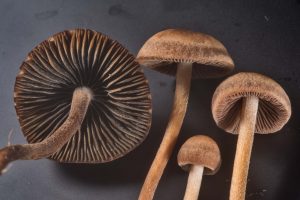
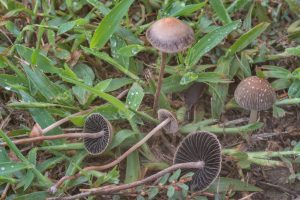
Panaeolus mushrooms[ix] are called mottlegills, because the uneven development of the spores. Or, they might simply be called pans. Some are pychoactive and some are not, mature unevenly, producing dark patches on the gills, or simply pans. Not all are “active,” and some authorities favor placing the psychoactive species in a new genus, Copelandia. New York has one or two of these active pans—The Turf Mottlegill (P. fimicola)[x] is only marginally psychoactive and may be mildly toxic, so it’s hard to be sure it really counts. The Banded Mottlegill (P. cinctulus)[xi] is more solidly active, it is not very potent, perhaps a better choice for micro-dosing than for tripping.
Pluteus
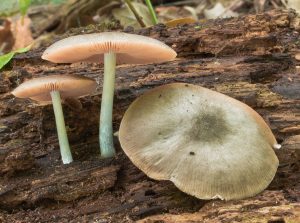
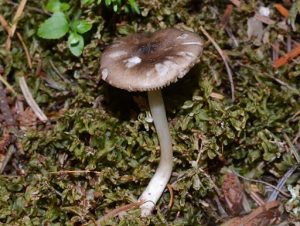
This genus[xii] is better known for its several edible species, including The Deer Mushroom, but it also has a few “active” members, two of which, P. americanus[xiii] and P. brunneidiscus, are known from New York. Neither is well-used or commonly used, so their potency is difficult to assess.
Psilocybe
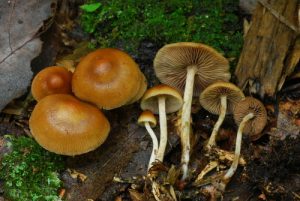
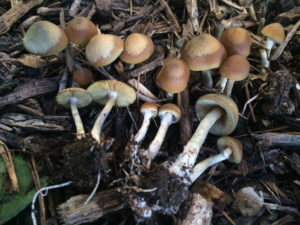
Psilocybe is the best-known “magic” genus, in part because of of its members, Psilocybe cubensis, is so widely cultivated. It’s also the genus for which is hallucinogenic substance, psilocybin, was named. New York has four Psilocybe species growing wild. Two, P. caerulipes[xiv] and P. ovoideocystidiata[xv], bear the common name, blue-foot, for the color of the base of the stem. The latter is the larger of the two. Psilocybe silvatica[xvi] is not very potent but can be used, and was featured in a Star Trek-themed comic, once[xvii]. P. liniformans var. Americana[xviii] has low potency and can cause allergic reactions, so it’s rarely used.
Poisonous Mushrooms in New York
The following list is by no means exhaustive—that is, knowing a mushroom is not one of these four is no guarantee the mushroom is safe to eat! But these species are among the more important to know, since three of them are regularly mistaken for edible species. The fourth is just too pretty to ignore.
Common Earthball (Scleroderma citrinum)
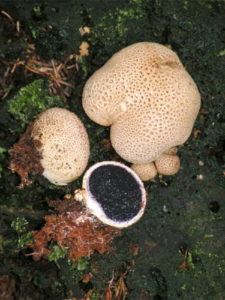
The common earthball[xix] is indeed ball-shaped, with a thick, warty skin that can be anywhere from white to brown or even green, but usually has a yellowish tinge. People who eat it usually wish they hadn’t. Eating is often the result of misidentification, as several edible puffballs are superficially similar. But earthballs are firmer than puffballs are, and their interiors start turning dark long before maturity.
The Sickener (Russula sp.)
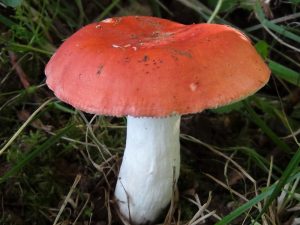
Mushrooms in the Russula genus are legendary in the problems they present for identification[xx]. Not only are many species both extremely variable and almost exactly alike other extremely variable species, but it’s not at all clear how many species they are or which ones are which. So we’re not going to even try to figure out which species New York has. The important point is that New York has Russulas, and you should not eat them. They are not usually lethal, and some might even be safe when well-cooked, but most will cause severe gastrointestinal upset[xxi].
These are very pretty mushrooms, mostly with brightly-colored caps of almost any color, and contrasting bright white stem and gills. They taste more or less peppery. The common name, sickener, was originally applied to Russula emetica, but that species has been divided and divided again, leaving it unclear which is which. It seems reasonable to apply the name to any red Russula. Collectively, members of the Russula genus are often called “brittlegills.”
Deathcap (Amanita phalloides)
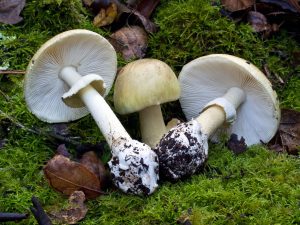
The Deathcap is only one of several members of its genus that kills most people who eat it (if you do eat one, don’t give up; call Poison Control right away and try to get a sample of the mushroom to give to the doctors. You have a chance). Deathcap is native to Europe, but has been accidentally introduced to much of the rest of the world on nursery stock. It’s a large, handsome mushroom with a greenish or brownish cap and a white stem. In its early “egg” stage, it closely resembles certain edible puffballs and it one of the reasons all puffballs headed for the table must be sliced vertically to check for hints of the internal structure of an Amanita. In its later developmental stages it is sometimes eaten by the curious or incautious, or by people familiar with a similar-looking edible mushroom in Asia.
Deadly Galerina (Galerina marginata)
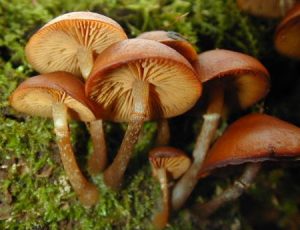
We can’t actually find confirmation of Deadly Galerina in New York, but it’s probably here—it’s definitely in several surrounding states. And not only does this species have a potentially lethal dose of the same toxin as The Deathcap, it’s also a close look-alike of several edibles and most of the popular psychoactive species. Worse, it has the same habitat as some of the safer species it resembles, sometimes growing intermixed with them in the same clump. It is absolutely critical to positively identify every single mushroom before eating.

My name is Austin Collins.
I've dedicated my life to Mushrooms.
I believe Mushrooms are the best kept secret when it comes to health and well being.
For that reason, I would like to share a company with you that in my opinion makes the best mushroom products on the market.
The company is called Noomadic Herbals, my favorite supplement they make is called "Mushroom Total".
I take their products every day and they have helped me think better and have more energy. Give them a try.
-Austin
References:
[i] Smith, D. (2008). Species List: Species of New York State (49). Mushroom Observer
[ii] Margulies, E. (2006). Eating Chicken of the Woods. Cornell Mushroom Blog
[iii] Kuo, M. (2017). Calvatia gigantea. MushroomExpert
[iv] Bergo, A. (n.d). Puffball Mushrooms. Forager Chef
[v] (2011). King Bolete (Boletus edulis and others). Mushroom-Collecting
[vi] (n.d.). Which Psilocybin Mushrooms Grow Wild in My Area? Shroomery
[vii] (n.d.). Gymnopilus luteofolius. Philosophy
[viii] Kuo, M. (2012). Gymnopilus luteus. MushroomExpert
[ix] (n.d.). Panaeolus. Wikipedia
[x] (n.d.). Panaeolus firmicola (Pers.) Gillet—Turf Mottlegill. First Nature
[xi] (n.d.). Panaeolus cunctulus. Philosophy
[xii] Kuo, M. (2015). The Genus Pluteus. MushroomExpert
[xiii] Kuo, M. (2016). Pluteus americanus. MushroomExpert
[xiv] (n.d.). Psilocybe caerulipes. Philosophy
[xv] Roderick (2019). Psilocybe ovoideocystidiata. Psillow
[xvi] (n.d.). Psilocybe silvatica. Philosophy
[xvii] (n.d.). Psilocybe silvatica. MemoryBETA
[xviii] Roderick (2020). Psilocybe limiformans. Psillow website, accessed October 16, 2021.
[xix] (n.d.). Scleroderma citrinum Pers. Gillet—Common Earthball. First Nature
[xx] Kuo, M. (2009). The Genus Russula. MushroomExpert.
[xxi] (n.d.). Russula emetica (Schaeff.)Pers.—The Sickener. First Nature


